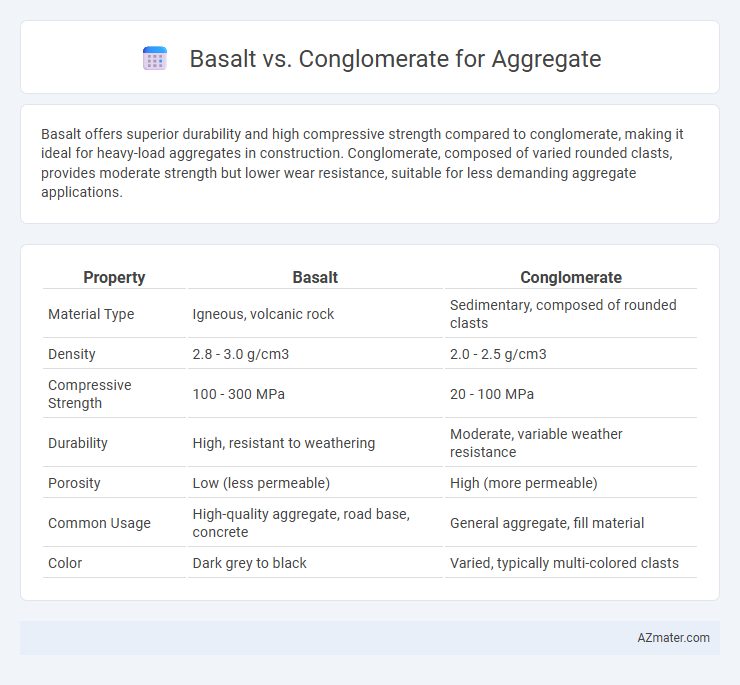Basalt offers superior durability and high compressive strength compared to conglomerate, making it ideal for heavy-load aggregates in construction. Conglomerate, composed of varied rounded clasts, provides moderate strength but lower wear resistance, suitable for less demanding aggregate applications.
Table of Comparison
| Property | Basalt | Conglomerate |
|---|---|---|
| Material Type | Igneous, volcanic rock | Sedimentary, composed of rounded clasts |
| Density | 2.8 - 3.0 g/cm3 | 2.0 - 2.5 g/cm3 |
| Compressive Strength | 100 - 300 MPa | 20 - 100 MPa |
| Durability | High, resistant to weathering | Moderate, variable weather resistance |
| Porosity | Low (less permeable) | High (more permeable) |
| Common Usage | High-quality aggregate, road base, concrete | General aggregate, fill material |
| Color | Dark grey to black | Varied, typically multi-colored clasts |
Introduction to Basalt and Conglomerate as Aggregates
Basalt, a dense volcanic rock, is widely used as an aggregate due to its high compressive strength, durability, and resistance to abrasion, making it ideal for construction and road bases. Conglomerate, a sedimentary rock composed of rounded gravel-sized clasts cemented together, serves as a natural aggregate with variable strength and porosity depending on the nature of its matrix and clast composition. The selection between basalt and conglomerate aggregates depends on factors like mechanical properties, availability, and project-specific requirements such as load-bearing capacity and exposure conditions.
Geological Formation of Basalt and Conglomerate
Basalt is an extrusive igneous rock formed from the rapid cooling of low-viscosity lava rich in iron and magnesium, typically found in volcanic regions and oceanic crust. Conglomerate is a sedimentary rock composed of rounded clasts cemented together, formed through the lithification of gravel-sized particles in riverbeds or alluvial fans. The dense, fine-grained structure of basalt provides high compressive strength, while conglomerate's heterogeneous composition depends on the nature of its clasts and matrix.
Physical Properties Comparison
Basalt exhibits higher compressive strength and durability compared to conglomerate, making it more suitable for high-load construction applications. Its fine-grained, dense structure contributes to superior abrasion resistance, whereas conglomerate's coarse, heterogeneous composition often results in lower uniformity and variable strength. Basalt's lower porosity also enhances its resistance to weathering and freeze-thaw cycles, improving long-term performance as an aggregate material.
Mechanical Strength and Durability
Basalt exhibits superior mechanical strength and durability compared to conglomerate, making it a preferred aggregate choice in construction projects requiring high load-bearing capacity. Its dense, fine-grained structure provides enhanced resistance to abrasion, crushing, and weathering, while conglomerate, composed of varied particle sizes and softer matrix materials, often shows reduced structural integrity. Consequently, basalt aggregates contribute to longer-lasting pavements and concrete structures, ensuring better performance under mechanical stress and environmental exposure.
Workability and Processing
Basalt offers superior workability as an aggregate due to its fine-grained texture and high strength, which allows for easier mixing and compaction in concrete production. Conglomerate, composed of variously sized and shaped clasts, often requires additional processing such as crushing and sorting to achieve consistent size and grading for optimal workability. Processing basalt involves minimal crushing and grading operations because of its uniformity, whereas conglomerate demands more extensive sorting and processing to ensure compatibility with construction standards and enhance concrete workability.
Suitability for Construction Applications
Basalt exhibits superior compressive strength and durability compared to conglomerate, making it highly suitable for high-stress construction applications such as road bases, concrete aggregates, and railway ballast. Conglomerate, composed of varied-sized rock fragments cemented together, tends to have lower mechanical strength and higher porosity, limiting its use to less demanding applications like landscaping or decorative aggregates. The dense, fine-grained texture of basalt offers better resistance to weathering and abrasion, ensuring longer-lasting performance in structural components.
Environmental Impact and Sustainability
Basalt aggregate is more environmentally sustainable than conglomerate due to its natural abundance, durability, and lower processing energy requirements. Conglomerate extraction can cause greater ecological disruption, including habitat loss and higher carbon emissions from intensive quarrying and transportation. Using basalt minimizes environmental impact by reducing resource depletion and supporting long-lasting construction materials with lower lifecycle carbon footprints.
Cost and Availability
Basalt is generally more expensive than conglomerate due to its higher density and superior durability, making it a preferred choice for high-strength construction projects. Conglomerate tends to be more readily available and cost-effective since it forms naturally in sedimentary environments and requires less processing. Availability of basalt is limited to volcanic regions, whereas conglomerate deposits are widespread, influencing project location and budget considerations.
Performance in Asphalt and Concrete Mixes
Basalt exhibits superior performance as an aggregate in asphalt and concrete mixes due to its high compressive strength, durability, and resistance to abrasion, resulting in enhanced structural integrity and longer service life. Conglomerate, while usable, typically has lower density and variable strength because of its heterogeneous composition, which can reduce the mix's overall stability and resistance to weathering. Basalt's uniform mineralogy contributes to better bonding with bitumen and cement, optimizing load distribution and reducing the risk of cracking in pavement applications.
Final Selection: Which Aggregate is Best?
Basalt is generally preferred over conglomerate for aggregate applications due to its superior hardness, durability, and abrasion resistance, making it ideal for high-strength concrete and road construction. Conglomerate, while suitable for some construction uses, often has variable composition and lower strength, which can lead to inconsistent performance under heavy loads. Final selection depends on specific project requirements, but basalt's consistent physical properties and longer lifespan typically make it the best aggregate choice.

Infographic: Basalt vs Conglomerate for Aggregate
 azmater.com
azmater.com